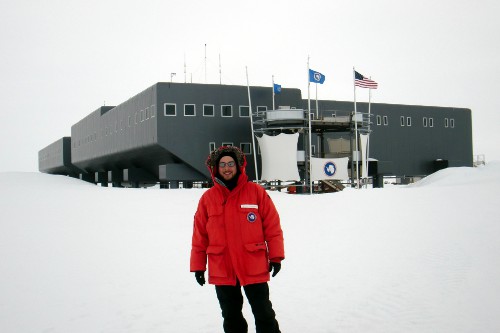 Me returning at the main station after today's afternoon outing.
Me returning at the main station after today's afternoon outing.
I started my day at 3:00 am with the second IceCube webcast, which was done in Spanish and was hosted by Dr. Silvia Bravo of the Wisconsin IceCube Particle Astrophysics Center (WIPAC). The webcast ran for a full hour and fifteen minutes—including an extensive questions-and-answers session—and was an absolutely enjoyable experience. We also had Stephan (here at the South Pole) and Megan (from Madison, Wisconsin) assisting with the webcast. I used my 30-minute presentation to give a summary of my work with PolarTREC so far, since my selection as a participant back in November 2013 to my current work with IceCube at the South Pole.
 IceCube webcast at the Arecibo Observatory Visitor's Center. Credit: Ruth E. Torres / Arecibo Observatory.
IceCube webcast at the Arecibo Observatory Visitor's Center. Credit: Ruth E. Torres / Arecibo Observatory.
 IceCube webcast at Pedro Rivera Molina School in Juncos, Puerto Rico. Credit: Miguel Piñero.
IceCube webcast at Pedro Rivera Molina School in Juncos, Puerto Rico. Credit: Miguel Piñero.
 IceCube webcast at Alfonso Díaz Lebrón School in Juncos, Puerto Rico. Credit: Sandra Jiménez.
IceCube webcast at Alfonso Díaz Lebrón School in Juncos, Puerto Rico. Credit: Sandra Jiménez.
Among the attendance were Gretchen from G Works, teachers and students from Pedro Rivera Molina school in Juncos, Puerto Rico—where I teach—, Sandra from Alfonso Díaz Lebrón school—also in Juncos and where I have also taught—, Ruth from the Arecibo Observatory, and Rachelis from Niños de Nueva Esperanza community project in Levittown, Puerto Rico. We also had the Hon. Ángel R. Peña-Ramírez of the Puerto Rico House of Representatives and Mr. Rubén Correa of the Juncos Municipal Education Department, as well as key officers from the Puerto Rico Department of Education including Ingrid Mercado who heads the 21st Century Community Learning Centers federal initiative.
 Sam checking up the data acquisition modules (DAQs) above an IceTop tank.
Sam checking up the data acquisition modules (DAQs) above an IceTop tank.
 Me carrying the DAQs away.
Me carrying the DAQs away.
The IceCube team has been working intensively with the IceTop experiment, so I went out again with Sam and walked over like one kilometer to one of the IceTop stations. We checked the equipment there and then took a couple of data acquisition modules (DAQs) back to the IceCube Laboratory (ICL). We carried them by foot for like half a kilometer.
 Me heading to the IceCube Laboratory (ICL) half a kilometer away.
Me heading to the IceCube Laboratory (ICL) half a kilometer away.
 Almost there.
Almost there.
We then arrived at the ICL's second level, where the IceCube operator's room and server room are located. While there I learned that Hans got his all-sky camera up and running, and that James has been successful with his calibrations and is now almost done. So, everything is coming together for the IceCube project, and it makes me proud to be part of this effort.
 Sam at the server room in the ICL.
Sam at the server room in the ICL.
 Me at the server room in the ICL.
Me at the server room in the ICL.

Comments